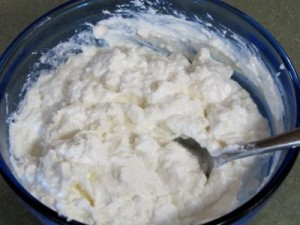Back in March, Alicia shared that she makes the best raw cream cheese from homemade buttermilk. We all assumed that she did it by dripping out the whey, but we wanted to know for sure. I wrote to her to find out if this was the case, and the reason we didn’t hear from her is that she didn’t get my messages until just the other day. Once she got the messages, she wrote back to me right away. Thanks, Alicia! And… here’s the answer for which we’ve all been waiting!
So here is how I do it and it is really very easy. I just set my quart jar of homemade buttermilk out on the counter for an extra day or until it really thickens, like almost yogurt consistency. Then strain through cheesecloth just as someone might to make yogurt cheese. It really is so much better than yogurt cheese is, to me.
For directions on how to drip out the whey, refer to the kefir cheese/yogurt cheese instructions in the Probiotic Potato Salad recipe.
...without giving up the foods you love or spending all day in the kitchen!

2 free books:
Eat God's Way
Ditch the Standard American Diet, get healthier & happier, and save money on groceries...
We only recommend products and services we wholeheartedly endorse. This post may contain special links through which we earn a small commission if you make a purchase (though your price is the same).



Wardee, I’d really love to try this! Can you go into the initial stages of making the buttermilk? Is it just the whey left over from making butter? Does it need to ferment before it becomes buttermilk? Do I need a starter?
Thanks so much!
.-= Faith´s last blog post… A Tribute to Summer =-.
Hi, Faith! The way I understand it there are two ways to get buttermilk – one is the byproduct of making butter. But I’m not sure that is “true” buttermilk. Please someone, correct me if I’m wrong. 🙂
The other is to innoculate whole milk with an actual buttermilk culture and let it culture for 12 to 18 hours.
Following this second method (using whole milk) will yield a better raw cream cheese because the buttermilk will be thicker and creamier.
You could purchase a buttermilk starter (see Resources for sources), but you could probably start with buttermilk from the store. With a commercial starter (the one that I know), you use 1/4 cup starter to 3/4 cup milk. If you’re using raw milk, you have to take special precautions to maintain the purity of the starter – in essence, pasteurize 3/4 cup of milk, let cool, and mix in 1/4 cup buttermilk from previous batch – this creates a starter with only the buttermilk bacteria predominant. If you used raw milk for your starter each time, the bacteria present in the milk will slowly kill the buttermilk bacteria.
Thanks for your great response. I really enjoyed checking out culturesforhealth.com and your water kefir post, which I can’t believe I never heard of before, even at a recent summer-long fermentation class I went to.
The girl that led the class was vegan and I asked about buttermilk and was told it was fermented whey, which never sounded very appealing. Your answer makes more sense. I was thinking, gosh, how do you make cheese with no fat? 🙂 Thanks again, great post.
Faith – It is surprising that your class wouldn’t have addressed water kefir – but then again, we’re all on this continuum of learning, aren’t we? I wouldn’t have thought fermented whey sounded appealing either. Let me know if you try it. I have a buttermilk culture in the fridge, just haven’t done it yet…
Wardah,
From what I understand, traditionaly cream to be made into butter was set aside for a once a week butter making time. By the time it was ready to be made, it had fermented to a cultured butter and the byproduct a type of cultured buttermilk that would be acidic enough to be used as a soaking liquid for your grain. But I am sure it doesn’t taste the same. I never even got used to the flavor of raw butter that I would make as it would always taste mildly fermented even when I made it fresh although I absolutly loved my raw milk. All that to say that yes, store buttermilk is cultered, but traditionally buttermilk was also naturally cultured.
Hope that helps a little.
Alicia
Alicia – That is SO interesting! Thank you for sharing what was done traditionally.
Wardee, how is the taste different with this than with the cheese we get from straining yogurt?
Thanks for joining in on Real Food Wednesday!
Kelly
.-= Kelly the Kitchen Kop´s last blog post… Julia Child – Cute Clips & Quotes =-.
Kelly – I don’t know – I haven’t tried it yet. But you can bet I will and soon. 🙂 I would imagine though that it is less tart, and probably tastes alot like buttermilk. 😉 Very helpful. Perhaps Alicia can help with this question?
I think the buttermilk cream cheese smells just like cream cheese from the store and the taste is some what milder. It actually could be a bit stronger for my taste but someone might try it with a bit of yogart cheese mixed in to see if it adds a bit more zip to it. Alas I can’t try it myself as we no longer have our dairy cows and don’t have access to any other raw milk. But the buttermilk cheese is great on it’s own though and is simpler to make than yogart cheese since yogart takes a more exact incubation temperature than buttermilk does.
Alicia